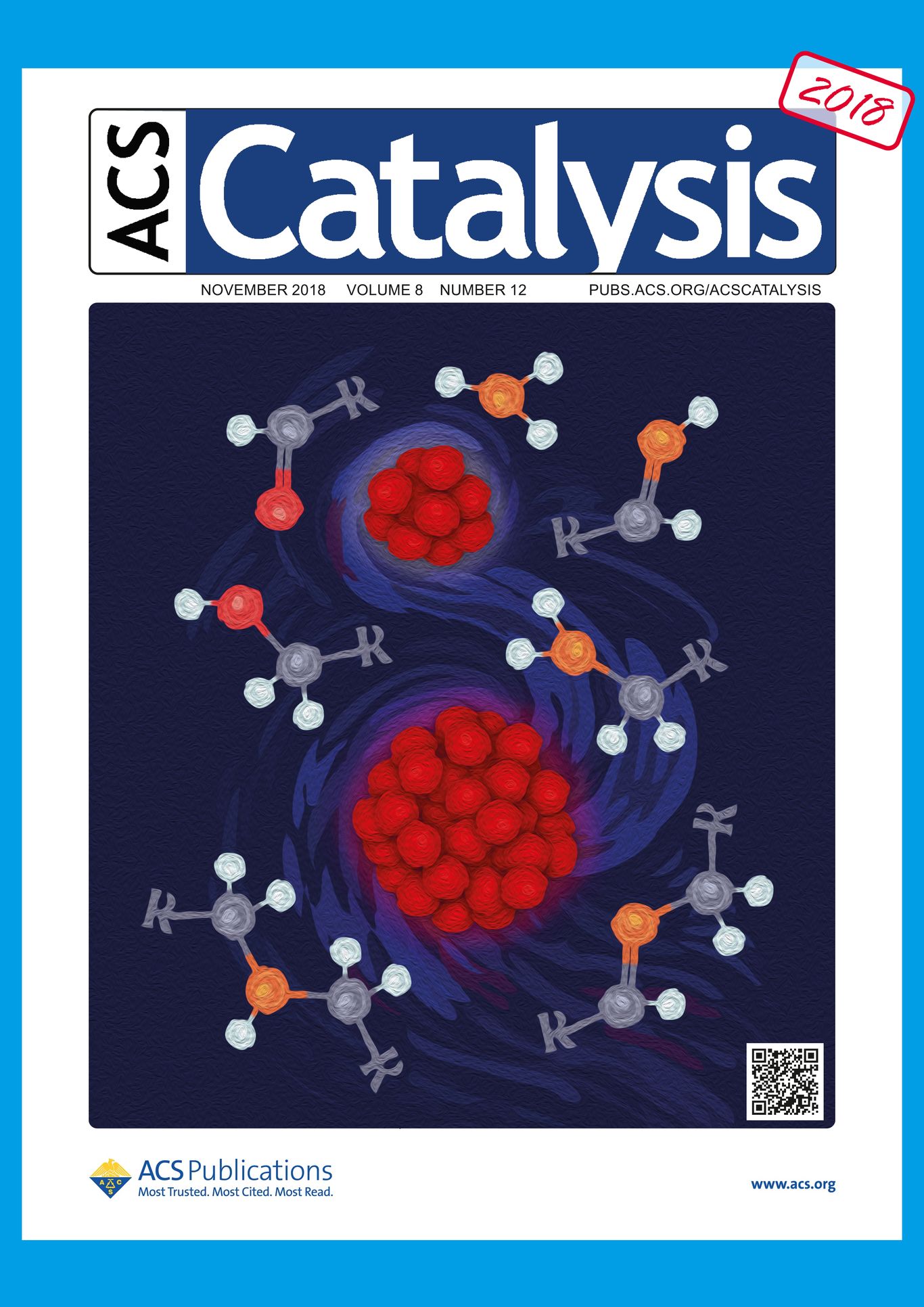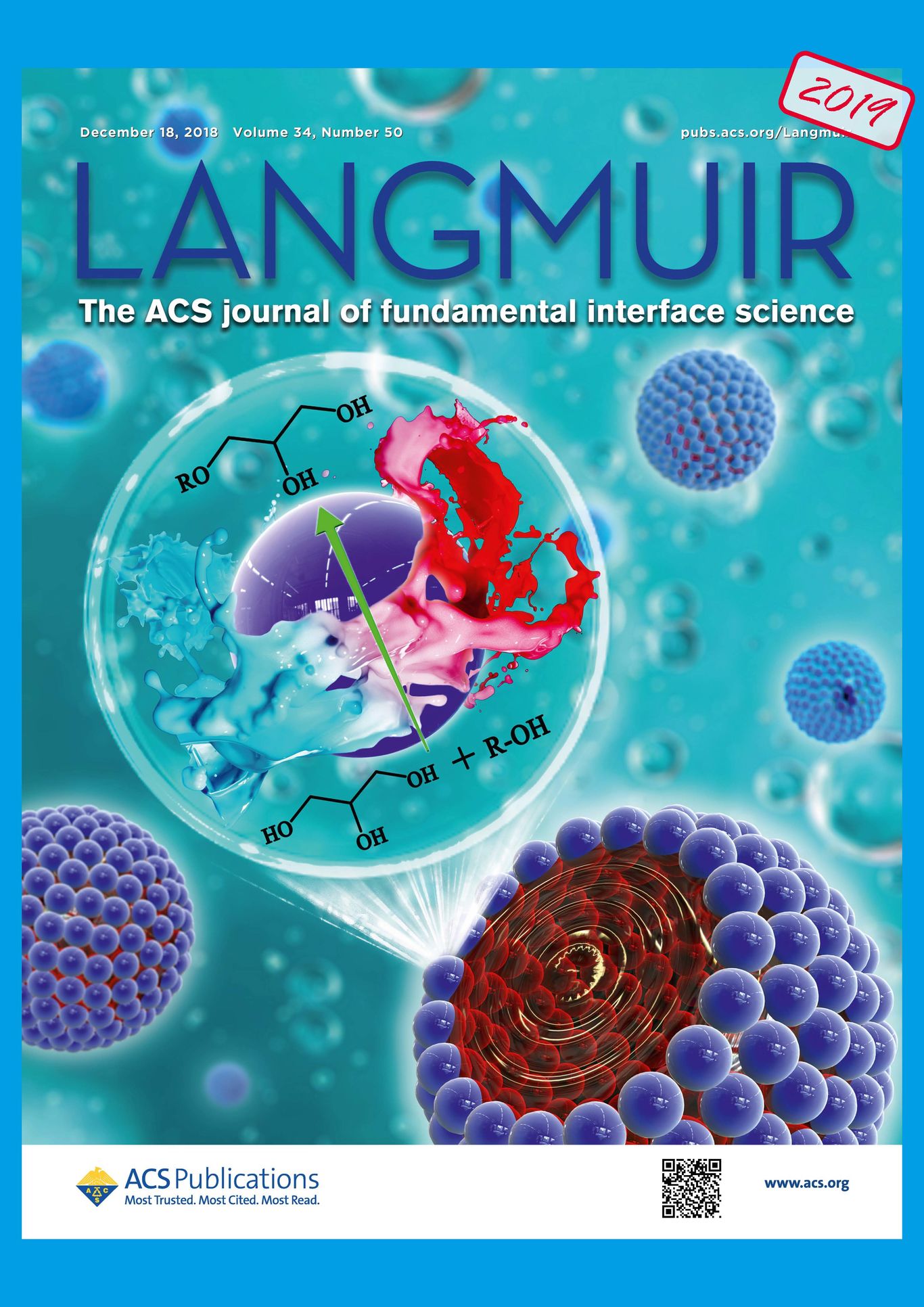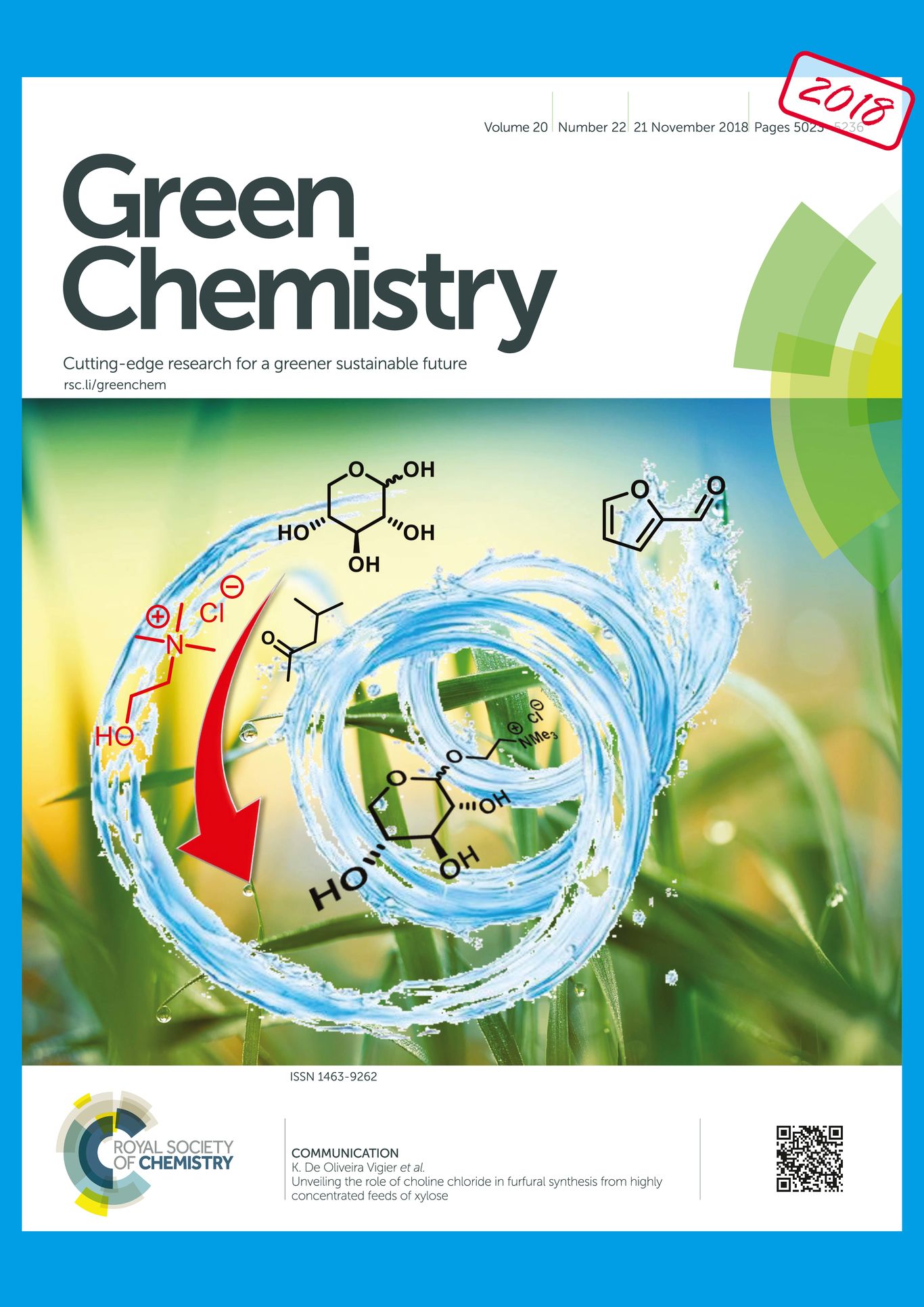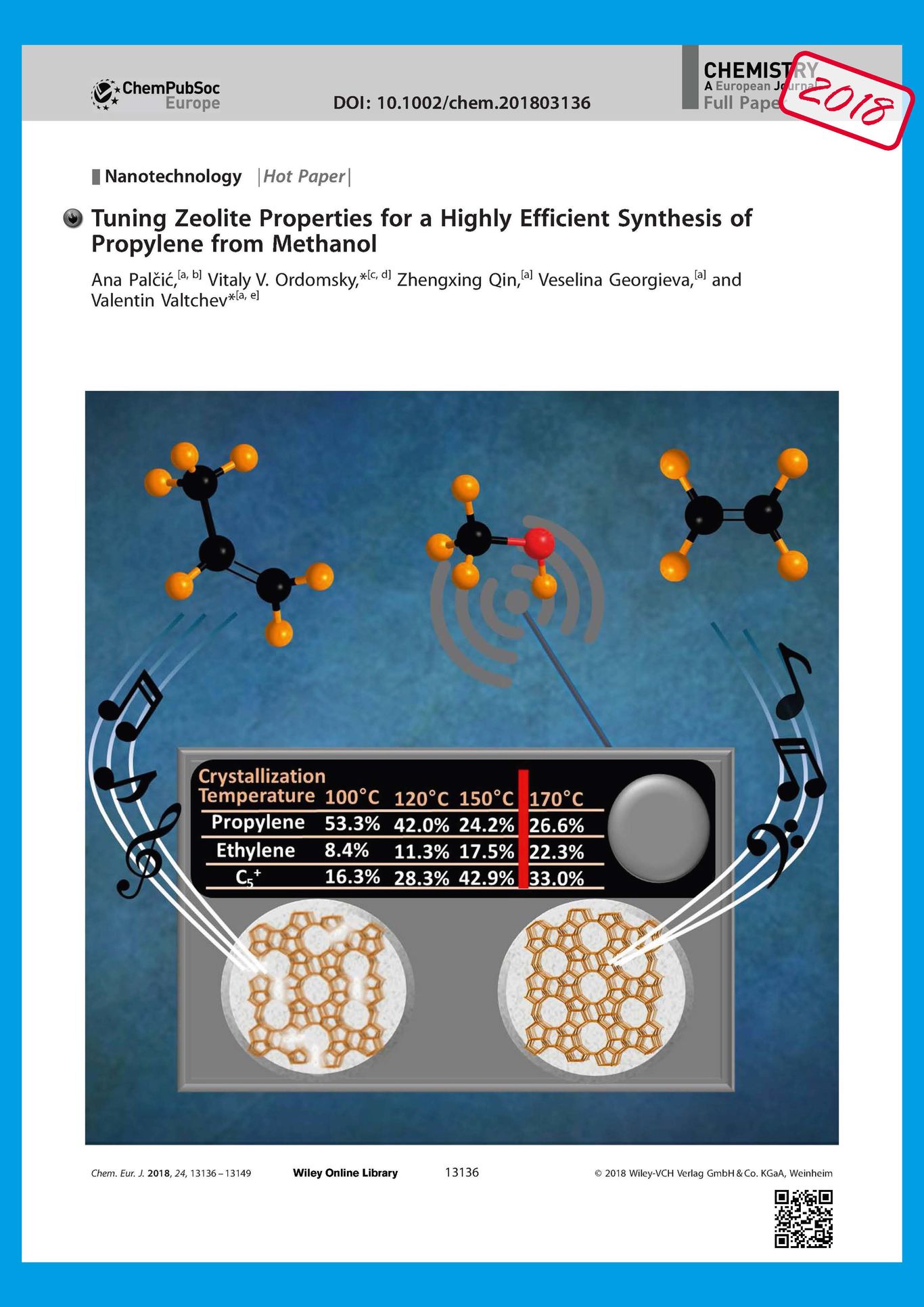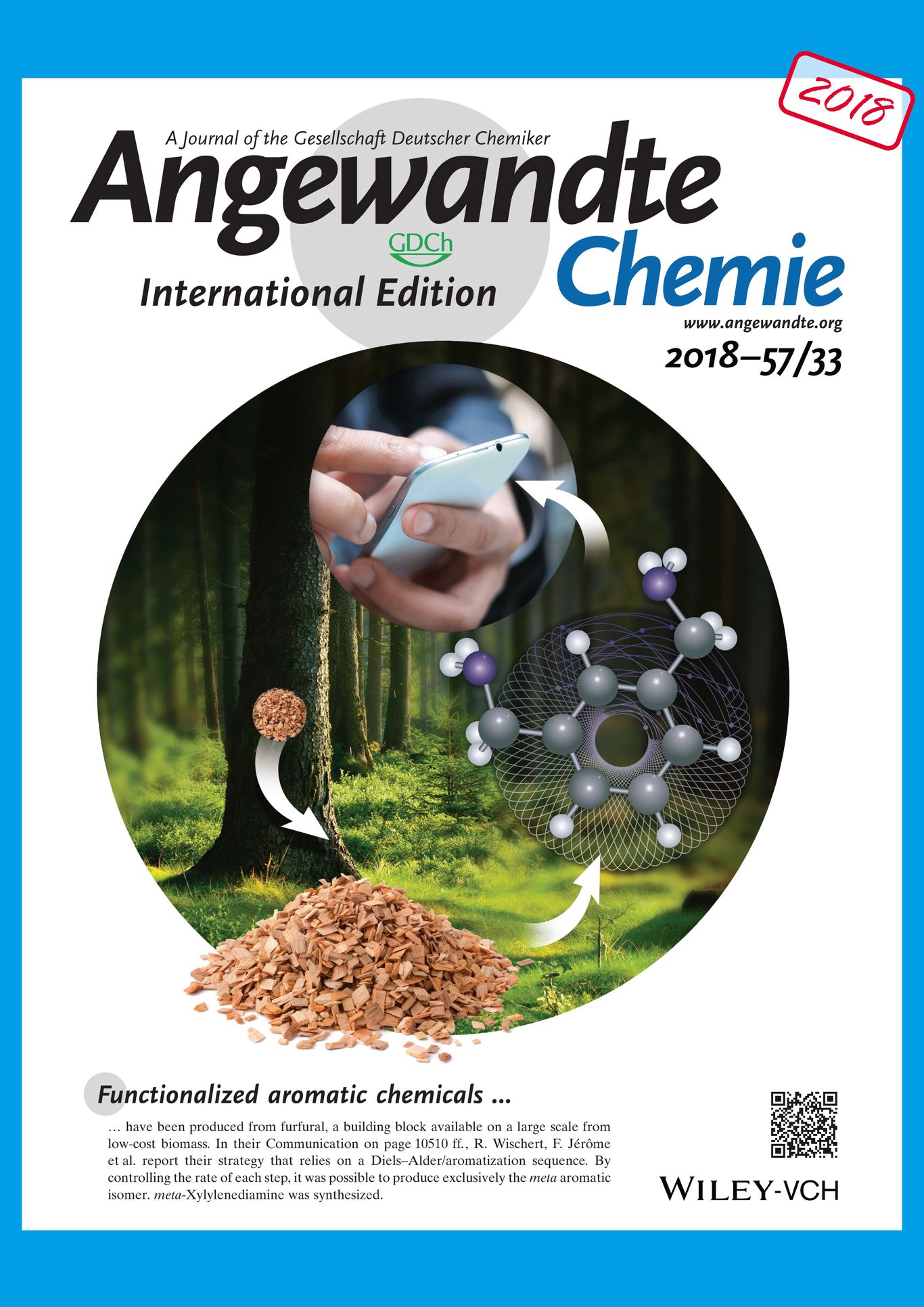2018 patents
- 19 patent applications
2018 publications
Y. Zhou, W. Baaziz, O. Ersen, P. Kots, V. Ordomsky, Chemistry of Materials (2018), 30 (22), 8116-8120.
Abstract
Synthesis of material
The commercial catalyst Pd/Al2O3containing 5 wt% of Pdhas been used in this work. The hydrogenation of the catalyst has been performed at 100 °C and 20 bar of hydrogen for 1 h. Afterwards0.1 g of the catalyst has been added to 10 ml of 30 wt% of H2O2solution under intensive stirring. The catalyst denoted as PdH-dec/Al2O3was filtered, washed with ethanol and dried at 50 ºC in vacuum.The catalyst Pd-dec/Al2O3has been prepared in the same way but without preliminary hydrogen absorption.
Characterization
The HAADF-STEM analyses were carried out on a JEOL 2100F (field emission gun) microscope operating at 200 kV by using a spot size of 1.1 Å with a current density of 0.5 pA·Å−1.The hydrogen pulse adsorption was performedusing AutoChem II 2920 apparatus from Micromeritics. 50 mg of sample was put in a quartz reactor, and then the samples were reduced in a flow of 5% H2/Ar flow (60 ml/min) with heating rate 10 ºC/min at 200 ºCfor 0.5 h.Afterwards the flow has been switched to pure Ar for 0.5 h for hydrogen desorption. After cooling down to room temperatureor 60 ºCthe catalyst has been treated by hydrogen pulses in argon flow till full saturation. The dispersion of Pd has been calculated by division of integrated adsorbed atoms of hydrogen by total amount of Pd atoms [E. Diaz, S. Ordonez, A. Vega, J. Coca, Chromatographia, 2005, 61, 285-290].Hydrogen TPD was carried out in argon flow at heating rate 10 ºC/min. XPS analysis has been performed in ThermoFischer ESCALAB 250X photoelectron spectrometer using monochromated X-ray irradiation AlKα (hv= 1486.7 eV) and 180° double focusing hemispherical analyzer with a six-channel detector. The BE (binding energy) of the photoemission spectra was calibrated against Al 2p peak with BE 74.5 eV. Reduction of samples in 900 mbar of hydrogen at 100ºC was performed in a UHV connected high pressure gas cell (Model HPGC 300, Fermi Instruments). After reduction the samples were kept in vacuum at 100ºC for some time. The photoelectron spectra were recorded after UHV transfer of the samples to analyzer chamber without contact with atmosphere.FTIR measurements are carried out on a Nicolet Protege spectrometer equipped with a MCTdetector. About 20 mg of the samples were pressed in self-supported wafer. The sample was then introduced in a glass cells specially designed for in-situ FTIR spectroscopy. The sample has been reduced at 200 ºC with subsequentcooling downto room temperature and vacuum. Carbon monoxide was then gradually introduced into the cell and IR spectra subsequently recordedtill full saturation of intensity of the lines. Difference spectra were obtained by the subtraction of the reference spectra from the spectra of the samples with adsorbed CO.
G. Liang, Y. Zhou, L. Zhao, A. Khodakov, V. Ordomsky, ACS Catalysis, (2018) 8, 11226-11234.
Abstract
| The reaction rates and selectivity of many metal-catalyzed reactions depend on the size of the metal particles in the nanoscale range. Primary amines are important platform molecules in the chemical industry. In this work, the catalytic performance of nonsupported Ru nanoparticles with sizes from 2 to 9 nm was investigated in direct amination of octanol and other alcohols into primary amines in the presence of ammonia. The 90% selectivity to octylamine was obtained over small Ru nanoparticles (d = 2 nm) even at 92% conversion, whereas for larger Ru nonsupported and supported nanoparticles, the octylamine selectivity dropped as the octanol conversion approached 70–80%. The primary reaction of alcohol amination into octylamine was found to be nearly a structure-insensitive reaction. The selectivity to primary amine drops over large Ru particles at higher conversions, because of the secondary highly structure-sensitive reaction of amine self-coupling. Over small metal nanoparticles, amine self-coupling is hindered, because of suppression of secondary imine hydrogenation. Similar structure sensitivities of the reactions involved in alcohol amination were observed for different substrates. |
G. Liang, Y. Zhou, L. Zhao, A. Khodakov, V. Ordomsky, ACS Catalysis, (2018) 8, 11226-11234.
Abstract
| Pickering emulsions offer a promising platform for conducting interfacial reactions between immiscible reagents. Despite the significant progress in the engineering of amphiphilic catalysts for such reactions, the mechanism behind their enhanced activity is still poorly understood. Herein, using the glycerol/dodecanol system as a case study, we conducted a combined meso- and microscale study of Pickering emulsions stabilized by amphiphilic silica nanoparticles bearing acid centers by marrying dissipative particle dynamics simulations with emulsification experiments. The optimal surface properties of the silica particles in terms of length and density of alkyl chains were identified, matching the experimental results. The local distribution of glycerol and dodecanol near the acid centers was ascertained, unraveling potential reactivity zones near the catalytic acid centers due to an enhanced nanomixing between glycerol and dodecanol. |
Y. Chen, N. Batalha, M. Marinova, M. Impéror-Clerc, C. Ma, O. Ersen, W. Baaziz, J. Stewart; D. Curulla-Ferré, A. Khodakov, V. Ordomsky, Journal of Catalysis, (2018) 365, 429-439.
Abstract
We report here a new strategy for the control of hydrocarbon selectivity in Fischer–Tropsch (FT) synthesis using silica yolk–shell ruthenium nanoreactors prepared in water/oil (W/O) microemulsions. The sizes of nanoreactors have been varied by changing the microemulsion composition. Nanoreactors prepared with the smallest internal volume exhibited a restriction of hydrocarbon chain length growth during FT synthesis. An increase in the nanoreactor volume resulted in a gradual shift of the hydrocarbon distribution to longer-chain hydrocarbons till a distribution of hydrocarbons reached that observed over the reference catalysts prepared by deposition of non-encapsulated metal nanoparticles on silica supports. The observed remarkable modifications of hydrocarbon selectivity over Ru nanoreactors have been explained by shape selectivity effects on hydrocarbon growth due to decrease in entropy in comparison with infinite growth and increase in the Gibbs energy for growing hydrocarbon chains located inside the limited volumes of nanoreactors.
J. Ibañez, B. T. Kusema, S. Paul, M. Pera-Titus, Catal. Sci. Technol. (2018), 8, 5858-5874.
Abstract
The present paper describes the synthesis of primary amines from long-chain aliphatic alcohols and ammonia using alumina-supported noble metal doped cobalt formulations with moderate cobalt loading (5 wt%). The influence of the noble metal nature, loading and impregnation sequence was studied in detail and comprehensively characterized using XRD, H2-TPR, CO-TPD and STEM-EELS/EDS. While all noble metals exerted a positive effect on the cobalt reducibility, Ag and Ru impacted to a higher extent the activity and selectivity for amine synthesis. The impregnation protocol was found to be critical with the best results being obtained for sequentially impregnated Ag–Co and co-impregnated Co(Ru) catalysts. Further optimization of the Ag and Ru metal loading led to two formulations affording a comparable activity to that of an alumina-supported catalyst containing 2.4 times more Co. At optimized conditions, the best formulation (5 wt% Co, 3 atom% Ag) afforded 90% conversion and 78% yield to 1-octylamine in the gas-phase amination reaction of 1-octanol with ammonia at 200 °C using 21 equiv. of ammonia compared to 1-octanol, which overcomes the maximum reported yield on benchmark Ni-alumina formulations (70%). Furthermore, this formulation showed high stability for at least 6 h on stream. A survey of the effect of the reaction variables on the catalytic performance revealed a co-catalytic effect of Ag, impacting positively both the activity and selectivity.
A. Tomer, B. T. Kusema, J-F. Paul, C. Przybylski, E. Monflier, M. Pera-Titus, A. Ponchel, J. Catal. (2018) 368, 172-189.
Abstract
This paper reports the use of β-cyclodextrin as a pre-shaping agent for the preparation of low-metal xNi-yPd/Al2O3 catalysts (x = 2, 5 wt% and y = 0.2, 0.5, 1.0 wt%) targeting the direct amination of 1-octanol with ammonia. Six different preparation methods were used aiming at tuning the Ni-Pd interaction. The catalysts were finely characterized by XRD, H2-TPR, CO pulse chemisorption, STEM-EELS/EDS-SDD and XPS, while the elementary interaction between Ni-Pd-cyclodextrin was assessed by marrying ESI-MS experiments with DFT calculations. Among the different methods studied, the most outstanding effect was obtained when β-cyclodextrin was pre-adsorbed on γ-Al2O3 before impregnating the Ni and Pd nitrate precursors. At such conditions, the best formulation (5Ni-0.5Pd/Al-CD_M4) afforded 90% conversion and 71% yield to 1-octylamine (TON = 93) in the amination of 1-octanol with ammonia at 160 °C for 4 h, which places it among the most active and selective Ni catalysts reported in the literature.
B. Hong, Z. Y. Fan, M. Pera-Titus, L’Actualité Chimique, (2018), 434, 19-25.
Abstract
Reactions between immiscible reagents in the presence of solid catalysts (liquid-liquid-solid, L-L-S reactions) are extensively used in the chemical industry. However, conventional reactors such as stirred tanks can suffer from strong mass/heat transfer limitations due to the poor contact between the phases and a reduced accessibility of the reactants to the catalyst surface.
For a major improvement on current systems in terms of cost efficiency, energy savings and environmental footprint, L-L-S reactors operating at the nanoscale are required. Recently, we have reported the Pickering interfacial catalysis (PIC) concept. It addresses the reaction between two immiscible reagents by the formation of L-L-S nanoreactors based on Pickering emulsions promoting the contact between the phases.
This paper presents an overview of recent examples of PIC systems developed at the E2P2L Laboratory in Shanghai and applied to industrially relevant reactions encompassing biomass-derived reagents for which reactivity is usually imprisoned due to low miscibility of the reagents. The PIC concept constitutes a hotbed for innovation, opening an avenue to the industrial synthesis of high added-value fine chemicals, specialties and biofuels that can only be afforded today using inefficient processes.
B. Hong, Z. Y. Fan, M. Pera-Titus, L’Actualité Chimique, (2018), 434, 19-25.
Abstract
Light olefins are important platform molecules in chemical industry. Fischer-Tropsch synthesis provides an alternative technology for direct synthesis of light olefins from syngas, which can be generated from renewable feedstocks such as organic waste, used plastics and biomass. The Bi- and Pb-promoted iron catalysts supported by carbon nanotubes have been prepared for direct conversion of syngas to lower olefins. Compared to the un-promoted iron catalysts, a twice higher Fischer-Tropsch reaction rate and higher selectivity to lower olefins were obtained. A combination of characterization techniques reveals remarkable migration the promoting elements, which occurs during the catalyst activation. After the activation, the iron carbide nanoparticles are decorated with the promoting elements. The lower melting points and high mobility of these two metal promoters during the catalyst activation are crucial for the intimate contact between Fe and promoters. The promoting effects of bismuth and lead result in a better reducibility and easier carbidisation of iron nanoparticles. The higher yield of light olefins over the carbon nanotube supported catalysts in the presence of promoters is due to slowing down secondary hydrogenation of olefins and a decrease in the chain growth probability.
S. Jiang, C. Verrier, M. Ahmar, J. Lai, C. Ma, E. Muller, P. Marion, Y. Queneau, M. Pera-Titus, F. Jerome, K. Oliveira-Vigier, Green Chem. (2018), 20, 5104-5110.
Abstract
| Furfural is a biomass derived compound used for the synthesis of fuels and chemicals. Herein we show that choline chloride allows the conversion of highly concentrated feeds of xylose (up to 50 wt%) to furfural (up to 75%) and that it can be recycled. Such a beneficial effect was observed from the formation of a choline xyloside intermediate exhibiting higher reactivity than xylose. |
S. Zhang, B. Hong, Z. Y. Fan, J. Y. Lu, Y. S. Xu, M. Pera-Titus, ACS Appl. Mater. Interfaces, (2018), 10 (31), 26795–26804.
Abstract
A key demand in biomass conversion is how to achieve high reactivity with immiscible reagents with the use of neither cosolvents nor additives. Pickering interfacial catalysis encompassing the design of amphiphilic catalysts behaving concomitantly as emulsifiers offers an elegant solution. In this study, we prepared a systematic series of amphiphilic Aquivion–carbon composites by the hydrothermal carbonization of guar gum with Aquivion perfluorosulfonic superacid. By tuning the Aquivion–carbon composition, materials with tunable hydrophilic-lipophilic properties could be prepared, showing high versatility for conducting biphasic reactions without stirring. In particular, an optimal formulation based on 5:1 Aquivion–carbon could be developed, showing high activity in the transesterification reaction of glyceryl trioleate with methanol at 100 °C with good reusability due to the genesis of stable Pickering emulsions.
A. Palcic, V. Ordomsky, Z. Qin, V. Georgieva, V. Valtchev, Chemistry - A European Journal (2018), 24 (50), 13136-13149.
Abstract
| A series of nanosized ZSM-5 samples was synthesized at 170, 150, 120, and 100 °C. Experimental data show that the decrease of crystallization temperature leads to significant changes in zeolite properties. Crystals synthesized at 100 °C exhibit many framework defects with lower acid-site density, strength, and a larger external surface area. The selectivity to light olefins and the propylene-to-ethylene ratio increases as the crystallization temperature decreases. A propylene-to-ethylene ratio of above 6 with the highest selectivity to propylene of 53 % was obtained over ZSM-5 catalyst prepared at 100 °C. The stability of the nanosized zeolite in methanol to olefins (MTO) was also improved compared to the industrial sample with a similar Si/Al ratio. This catalytic performance is a result of the decrease in the acid-site density, strength, and the crystals’ size, providing a shorter diffusion path and larger external surface area. The presence of structural defects and a different external surface in the crystals has been shown to play an important role in the MTO catalyst performance. |
B. Gu, A. Khodakov, V. Ordomsky, Chemical Communications, 54 (2018) 2345
Abstract
| A shift of selectivity to long chain α-olefins has been observed during Fischer–Tropsch synthesis over Co catalysts in the presence of carboxylic acids. The total selectivity to α-olefins of 39% was obtained in the presence of acids. The effect has been ascribed to intermediate formation of esters which hinder secondary olefin hydrogenation. |
P.-A. Payard, Q. Gu, W. Guo, Q. Wang, M. Corbet, C. Michel, O. Sautet, L. Grimaud, R. Wischert, M. Pera-Titus, Chem. Eur. J. (2018), 24, 14146-14153.
Abstract
Among the best‐performing homogeneous catalysts for the direct amination of activated secondary alcohols with electron‐poor amine derivatives, metal triflates, such as aluminum triflate, Al(OTf)3, stand out. Herein we report the extension of this reaction to electron‐rich amines and activated primary alcohols. We provide detailed insight into the structure and reactivity of the catalyst under working conditions in both nitromethane and toluene solvent, through experiment (cyclic voltammetry, conductimetry, NMR spectroscopy), and density functional theory (DFT) simulations. Competition between aniline and benzyl alcohol for Al in the two solvents explains the different reactivities. The catalyst structures predicted from the DFT calculations were validated by the experiments. Whereas a SN1‐type mechanism was found to be active in nitromethane, we propose a SN2 mechanism in toluene to rationalize the much higher selectivity observed when using this solvent. Also, unlike what is commonly assumed in homogeneous catalysis, we show that different active species may be active instead of only one.
I. Scodeller, S. Mansouri, D. Morvan, E. Muller, K. De Oliveira Vigier, R. Wischert, F. Jérôme, Angew. Chem. Int. Ed. (2018), 57, 10510-10514 .
Abstract
| We report the synthesis of biomass‐derived functionalized aromatic chemicals from furfural, a building block nowadays available in large scale from low‐cost biomass. The scientific strategy relies on a Diels–Alder/aromatization sequence. By controlling the rate of each step, it was possible to produce exclusively the meta aromatic isomer. In particular, through this route, we describe the synthesis of renewably sourced meta‐xylylenediamine (MXD). Transposition of this work to other furfural‐derived chemicals is also discussed and reveals that functionalized biomass‐derived aromatics (benzaldehyde, benzylamine, etc.) can be potentially produced, according to this route. |
Renhe Wang, Mengjia Wu, Servane Haller, Pascal Métivier, Yonggang Wang, Yongyao Xia, Chemistry-A European Journal (2018), 24 (41), 10310-10314.
Abstract
Crossover of liquid fuel remains a severe problem for conventional direct liquid fuel cells even when polymer electrolyte membranes are applied. Herein, we report for the first time a membrane‐free direct liquid fuel cell powered by alkaline hypophosphite solution. The proof‐of‐concept fuel cell yields a peak power density of 32 mW cm−2 under air flow at room temperature. The removal of the polymer electrolyte membrane is attributed to the high reactivity and selectivity of Pd and α‐MnO2 towards the hypophosphite oxidation on the anode and oxygen reduction on the cathode, respectively. The discharge products are analyzed by 31P NMR spectroscopy and the faradaic efficiencies have been calculated after discharging at 10 mA cm−2 for 20 hours. The non‐toxicity of hypophosphite and membrane‐free fuel cell structure provide huge potential for future applications.
A. Chappaz, J. Lai, K. De Oliveira Vigier, D. Morvan, R. Wischert, M. Corbet, B. Doumert, X. Trivelli, A. Liebens, F. Jérôme, ACS Sustain. Chem. Eng. (2018), 6, 4405–4411.
Abstract
Herein, we describe an efficient and recyclable catalytic system based on metal triflates capable of converting highly concentrated feeds of furfuryl alcohol (30–40 wt %) to alkyl levulinates in excellent yields (>90%). This constitutes a unique and important advance in the field. Indeed, the dilution of feedstocks represent one of the major bottlenecks in catalysis for the industrial deployment of biobased fuels and chemicals in our society. The impact of water in the metal triflates catalytic performances is also discussed. A comparison with a commercialized process (SFOS) shows that this catalytic route is in line with industrial requirements in terms of yield, selectivity, reactor productivity, and capacity. In particular, unprecedented space time yields up to 200 kg m–3 h–1 were obtained.
A. S. Dumon, J. Ibañez, A. Tomer, Z. Yan, R. Wischert, P. Sautet, M. Pera-Titus, C. Michel, Catal. Sci. Technol. (2018), 8, pp. 611-621.
Abstract
The direct amination of alcohols by ammonia is a promising sustainable route to primary amines. The development of novel heterogeneous catalysts calls for a better understanding of this reaction. Through a combination of well-designed catalytic tests and periodic DFT computations, we provide here a deeper understanding of the factors determining the activity of Ni and Pd catalysts. In particular, we demonstrate that a proper assessment of the relative activity requires the inclusion of a spectator species, namely ammonia, which modifies the rate limiting intermediate and transition state and thus affects the overall predicted activity. This better understanding paves the road for a rational improvement of metal-based catalysts.
T. Wang, Z. Yan, C. Michel, M. Pera-Titus, P. Sautet, ACS Catal. (2018), 8, 63-68.
Abstract
Understanding and predicting the nature of transition-metal surfaces under realistic pressure and temperature conditions is crucial for optimizing their catalytic, mechanical, or electronic properties. We focus here on the stability of transition-metal surfaces submitted to a pressure of NH3 and H2 and on the potential formation of metastable or stable surface nitrides. Our leading example is a Ni-based alcohol amination catalyst, studied by a combination of DFT, thermodynamic modeling, and experiments. Initial N-coverage on Ni nanoparticles selectively occurs on (100) facets, which become the most stable terminations. Concomitantly, the equilibrium shape of the particle becomes modified under a realistic gas-phase environment of NH3 and H2. Extreme conditions favor the genesis of metastable Ni3N nanoparticles, mainly exposing (101) terminations. Transformation into Ni and gas-phase N2, favored by thermodynamics, is kinetically hindered. H2 controls the catalyst nitridation by the competition between H-covered and N-covered surfaces. Extension to 15 transition metals unveils a huge spectrum of nitridation behaviors arising from very reactive Mo to almost inert Au. Nonetheless, in several cases, a moderate H2 pressure is sufficient to prevent nitridation under a pressure of NH3. The approach presented in this study gives insight into the surface nitridation behavior of transition metals, paving the way to in silico design under real conditions for applications in materials science and heterogeneous catalysis.
2017 patents
- 15 patent applications
2017 Publications
X. Lu, W.-J. Zhou, Y. Guan, A. Liebens, P. Wu, Catal. Sci. Technol. (2017), 7, pp. 2624-2631.
Abstract
A series of Ni/Al2O3 catalysts with variable Ni loading (2–20 wt%) were prepared by aqueous wet impregnation of a nitrate precursor using native cyclodextrins as metal complex hosts. The impact of β-CD was carefully characterized at different stages of the preparation by a set of complementary techniques including TG-MS analysis, mass spectrometry, X-ray diffraction, temperature-programmed reduction, CO pulse chemisorption, X-ray photoelectron spectroscopy and electron microscopy. It was found that the use of cyclodextrins afforded a much higher Ni dispersion and narrower distribution of Ni particle sizes, as well as a much higher availability of reduced surface Ni species. As a result, the cyclodextrin-assisted catalysts exhibited enhanced catalytic properties in the direct amination of benzyl alcohol with aniline and 1-octanol with ammonia, both operated via the hydrogen borrowing mechanism. Furthermore, the use of cyclodextrins allowed a significant improvement of the robustness of the catalysts by mitigating the nickel leaching during reaction.
T. Cao, M. Wu, V. V. Ordomsky, X. Xin, H. Wang, P. Métivier, M. Pera-Titus, ChemSusChem (2017), 10, 4851–4854.
Abstract
2,5‐furandialdehyde (DFF) was synthesized by electrogenerative oxidation of 5‐hydroxymethylfurfural (HMF) over a PtRu catalyst with 89 % selectivity at 50 °C after 17 h. This approach opens an avenue for a selective, energy‐efficient and green oxidation of biomass‐derived platform alcohols to added‐value chemicals.
X. Lu, W.-J. Zhou, Y. Guan, A. Liebens, P. Wu, Catal. Sci. Technol. (2017), 7, pp. 2624-2631.
Abstract
Fluorine-implanted titanosilicate Ti-MWW, with greatly enhanced catalytic performance in the liquid-phase epoxidation of ethylene with aqueous hydrogen peroxide, has been post-synthesized by fluorinating conventional Ti-MWW with NH4F. The effects of fluorination conditions, such as solvent, the amount of NH4F addition and temperature, on the zeolite structure and the catalytic performance of the resultant fluorine-implanted Ti-MWW were investigated in detail. Methanol proved to be a better solvent for fluorination than water in terms of preserving the crystalline structure and improving the selective epoxidation activity. Fluorine-implanting generated SiO3/2F species in the framework to increase the electropositivity of the tetrahedral Ti active sites. A stronger hydrogen-bond was thus formed between Hend in Ti–Oα–Oβ–Hend intermediates and the adjacent Si–F species, which were helpful to significantly increase the catalytic activity in the epoxidation of ethylene with H2O2. In addition, the fluorination also generated secondary mesopores which are useful to improve the accessibility of the active sites, making the fluorine-implanted Ti-MWW catalyst possess better reusability than the parent one.
A. Tomer, F. Wyrwalski, C. Przybylski, J.-F. Paul, E. Monflier, et al., J. Catal. (2017), 356, pp. 111-124.
Abstract
A series of Ce@MOR hybrids based on CeOx nanoparticles (1–2.5 nm) encapsulated in mordenite exhibiting a genuine flower-like morphology were prepared by simple hydrothermal synthesis. The cerium content in the catalysts could be easily tuned by adjusting the Si : Al : Ce composition of the preformed gel, affecting the textural properties and the density of acid sites of the catalysts. The genesis of acid sites with medium strength was directly correlated to the catalytic activity for the vapor-phase dehydration of 1,3-butanediol into butadiene. A Ce@MOR hybrid with a Si/Ce atomic ratio of 50 displayed a superior activity and selectivity compared to the parent MOR at a comparable Si/Al atomic ratio (10), as well as to control Ce-MOR catalysts post-synthesized by incipient wetness impregnation from the parent mordenite. A higher density of Brønsted acid sites with medium strength induced by encapsulated CeOx nanoparticles was argued as the main reason for such an enhanced catalytic performance.
P. Li, R. Wischert, P. Metivier, "Mild Reduction of Phosphine Oxides with Phosphites To Access Phosphines", Angew. Chem., Int. Ed. (2017), 56, pp. 15989-15992.
Abstract
| A new method for the iodine‐catalyzed reduction of phosphine oxides with phosphites at room temperature is reported. The mild reaction conditions, scalability, and simple purification requirements render it a method of choice for the large‐scale production and facile regeneration of a variety of phosphines. Mechanistic studies, supported by DFT calculations of the oxygen transfer between the starting phosphine oxide and the phosphite reagent, are also presented. Such transmutations of phosphorus species were previously unknown. |
A. Tomer, Z. Yan, A. Ponchel, M. Pera-Titus, J. Catal. (2017), 356, 133-146.
Abstract
The present study focuses on the selective synthesis of primary amines from aliphatic alcohols and ammonia using alumina-ceria supported nickel formulations based on very low nickel loading (≤2 wt%) and without any additive or external H2 supply. The effect of the catalyst preparation methods and modes of nickel impregnation were studied in detail and comprehensively characterized. The best formulation afforded 80% n-octanol conversion with 78% selectivity to n-octylamine at optimized reaction conditions, which were far better than control catalysts and benchmark Ni-alumina formulations relying on high Ni loadings. The enhanced activities of the alumina-ceria supported nickel catalysts was attributed to three combined effects: (1) a higher reducibility of surface nickel oxide species, (2) the genesis of very small and homogeneously distributed nickel nanoparticles (2–3 nm), and (3) a strong decline in the formation of nickel aluminates. Furthermore, unlike benchmark Ni catalysts, these formulations afforded a higher resistance to leaching.
H. Shi, Z. Y. Fan, B. Hong, M. Pera-Titus, ChemSusChem. (2017), 10, 3363-3367.
Abstract
Rational design of the surface properties of heterogeneous catalysts can boost the interfacial activity in biphasic reactions through the generation of Pickering emulsions. This concept, termed Pickering interfacial catalysis (PIC), has shown promising credentials in acid‐catalyzed transesterification, ester hydrolysis, acetalization, etherification, and alkylation reactions. PIC has now been applied to the efficient, solvent‐free hydrolysis of the triglyceride glyceryl trilaurate to lauric acid, catalyzed by Aquivion perfluorosulfonic superacid at mild conditions (100 °C and ambient pressure).
S. Adjimi, J.M. García-Vargas, J.A. Díaz, L. Retailleau, S. Gil, M. Pera-Titus, Y. Guo, A. Giroir-Fendler, Appl. Catal. B: Environ. (2017), 219, 459-466.
Abstract
The influence of addition of a series of non noble and noble metals to a manganese oxide octahedral molecular sieve (OMS) with a cryptomelane structure (K-OMS-2) has been studied for NO oxidation in view of fast selective catalytic reduction applications. Fe, Cu, Zn, Pt, Pd, Ru and Ag were selected as dopant metals with a metal loading around 2 wt.%. The catalysts were characterized in detail by ICP-OES, N2 adsorption/desorption at 77 K, XRD, H2-TPR and HR-TEM. The highest NO conversion was obtained for a K-OMS-2 catalyst modified with ruthenium, showing a reaction rate up to 5.3 μmol g−1 s−1 at 584 K. A markedly higher catalyst reducibility upon incorporation of ruthenium can be proposed as an underlying reason for the enhanced catalytic performance.
V. L. Sushkevich, P. A. Kots, I. I. Ivanova, M. Marinova, S. Moldovan, O. Ersen, V. V. Ordomsky, Chem. Mater. (2017), 29, 2676-2680 .
Abstract
Description of synthesis procedure, characterization, catalytic tests, TEM images, TGA elemental analysis, catalysis (ethanol esterification) and liquid phase NMR
F. Jing, B. Katryniok, S. Paul, L. Fang, A. Liebens, B. Hu, F. Dumeignil, M. Pera-Titus, ChemCatChem. (2017), 9, 258-262.
Abstract
SBA‐15 catalysts doped with variable aluminum amounts were prepared through a facile evaporation‐induced self‐assembly process. The textural properties and acidity of the catalysts could be tuned simply by varying the aluminum content. The genesis of acid sites with weak and medium strength during reaction was directly correlated to the catalytic activity for the dehydration of 1,3‐butanediol into butadiene (BD). The best performance was achieved over an Al‐SBA‐15 sample with a silica/alumina ratio of 76, exhibiting a stable BD yield of 59 % at temperatures as low as 200 °C.

